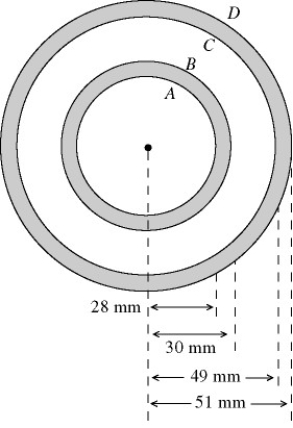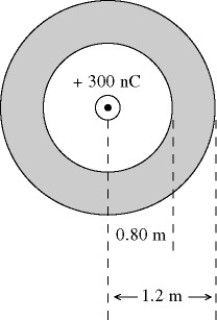Filters
Question type
A) -1.1 nC.
B) 1.1 nC.
C) -2.4 nC.
D) -4.8 nC.
E) 4.8 nC.
Correct Answer

verified
Correct Answer
verified
Question 32
Short Answer
Two extremely large nonconducting horizontal sheets each carry uniform charge density on the surfaces facing each other.The upper sheet carries +5.00 µC/m2.The electric field midway between the sheets is 4.25 × 105 N/C pointing downward.What is the surface charge density on the lower sheet? (ε0 = 8.85 × 10-12 C2/N • m2)
Correct Answer

verified
Correct Answer
verified
Question 33
Multiple Choice
A very large sheet of a conductor carries a uniform charge density of 4.00 pC/mm2 on its surfaces.What is the electric field strength 3.00 mm outside the surface of the conductor? (ε0 = 8.85 × 10-12 C2/N • m2)
A) 4.52 × 105 N/C
B) 2.26 × 105 N/C
C) 9.04 × 105 N/C
D) 0.452 N/C
E) 0.226 N/C
Correct Answer

verified
Correct Answer
verified
Question 34
Multiple Choice
The cross section of a long coaxial cable is shown in the figure,with radii as given.The linear charge density on the inner conductor is -30 nC/m and the linear charge density on the outer conductor is
-70 nC/m. The inner and outer cylindrical surfaces are respectively denoted by A,B,C,and D,as shown.(ε0 = 8.85 × 10-12 C2/N • m2) The radial component of the electric field at a point that 34 mm from the axis is closest to 
A) -16,000 N/C.
B) +16,000 N/C.
C) -37,000 N/C.
D) +37,000 N/C.
E) zero
Correct Answer

verified
Correct Answer
verified
Question 35
Multiple Choice
A hollow conducting spherical shell has radii of 0.80 m and 1.20 m,as shown in the figure.The sphere carries a net excess charge of -500 nC.A point charge of +300 nC is present at the center.
(k = 1/4πε0 = 8.99 × 109 N • m2/C) The radial component of the electric field at a point that is 0.60 m from the center is closest to 
A) zero.
B) +5000 N/C.
C) +7500 N/C.
D) -5000 N/C.
E) -7500 N/C.
Correct Answer

verified
Correct Answer
verified
Question 36
Multiple Choice
Two long straight parallel lines,#1 and #2,carry uniform positive linear charge densities.The charge density on line #2 is twice as great as the charge density on line #1.The locus of points where the electric field due to these lines is zero is
A) along a line between the lines closer to line #2 than line #1.
B) at a point midway between the lines.
C) along a line perpendicular to lines #1 and #2.
D) along a line between the lines closer to line #1 than line #2.
Correct Answer

verified
Correct Answer
verified
Showing 41 - 46 of 46
Related Exams